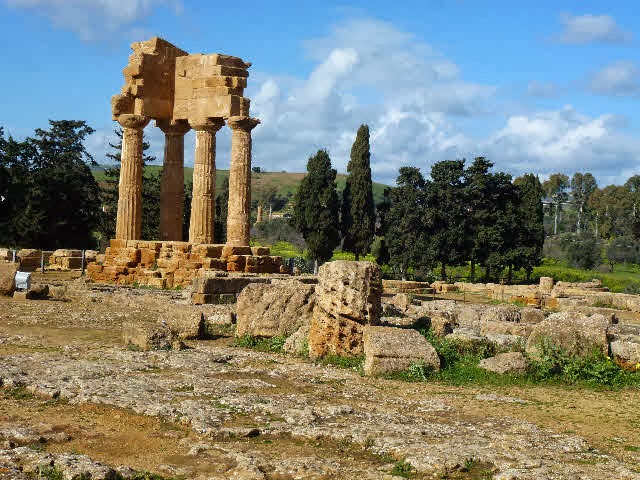Greeks from a nearby colony founded the original town in 581
BC. They sited it on a ridge, a good defensive position. The town thrived and was
enclosed by a mighty wall with nine gates.
Five main temples have been identified within the town
perimeter and form the most impressive such group outside of Greece according
to the experts. We entered through one of the old town gates, straight into the
ruins of the temple of Castor and Pollux, the Greek Ant and Dec.
There are pieces of temple scattered everywhere, and the elegant
columns in the photo were assembled in 1836 from unrelated bits, like temple
Lego.
The next temple we came to was apparently the largest of
this type anywhere in the Greek world: the Temple of Olympian Zeus. It was
never fully completed, and what is left lies in tumbled blocks, the result of
earthquakes, destructive raids and, most significantly, stone quarrying by the
locals. They built the port of Empedocle nearby with Zeus’ stone in the 18th
century, and there’s still plenty left.
An interesting feature is one of the main temple columns,
lying on its side. The upper part of this column is an Atlas figure with his
arms raised over his head simulating bearing the weight of the building. He
obviously got tired and put his arms down because the temple collapsed.
From here on the temples start to look like temples. This next
photo is the Temple of Juno, looking down from its elevated position. All the
temples are dated from the 5th century BC so have done well to
survive in any shape really.
On the site complex is a large house of more recent times.
The bronze bust in the entrance is that of a tireless benefactor of the
archaeological site who lived in the house from 1921 to 1933. He was Captain
Alexander Hardcastle, a retired English army officer whose money came from
inheriting the family bank. In 1933 the bank went bust; shortly after, poor old
Capt. H entered the local lunatic asylum where he died a little later. Well, he
was nuts about archaeology from his first visit here.
The Tempio della Concordia has to be one of the most
beautiful ancient temples anywhere. It is remarkably intact and so perfectly
proportioned that you keep taking pictures of it from every imaginable angle. They
were all good when viewed on the computer later, so out of the window goes my resolve
to ruthlessly prune down my huge harvest of digital snaps.
Taking photos is so much easier at this time of the year: no
crowds, so you also don’t have to wait for, say, a group of schoolkids to stop
swarming over the subject, or that bloke if the bright red anorak to move out
of frame.
Superb, isn’t it? The next shot shows part of the line of the
original city walls featuring our favourite temple in the distance.
The wall themselves were used by later occupants of the city, in the early Christian era, as burial tombs. You can see below how the stone has been hollowed out into chambers; tombites, so to speak.
A friendly French tourist offered to take our photo with a
600 year old olive tree (actually, she used my camera). Here we are with Olive
and, over on the right, a recent bronze statue lying on its side looking like a
giant anteater. I’m not sure why they need a modern work here when there is so
much genuine antiquity to see.
The Valley of the Temples isn’t a valley at all, it’s a ridge
offering fine views down to the sea and up into the hills. Most of all, the
site radiated tranquillity; you almost wanted to whisper in deference to all that
accumulated history. I imagine, in its
day, it was anything but quiet; full of busy people going about their daily lives.
Throw in the odd earthquake and Carthaginian attack and they would maybe think
our lives today the more peaceful.




















































